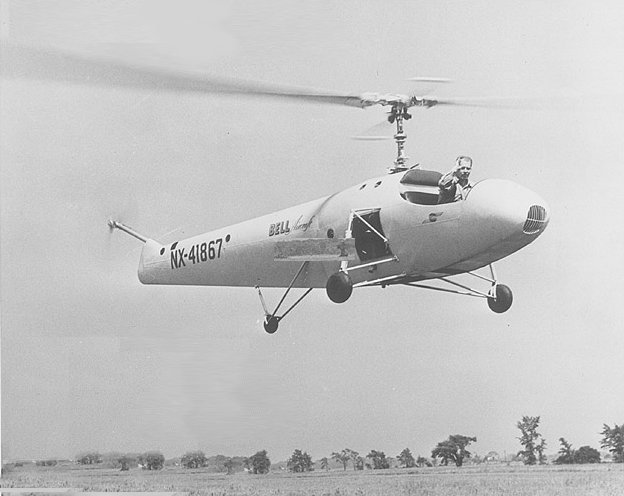| Picture |

|
| Manufacturer |
Bell
|
| Type |
Model 30
|
| Introduced |
7/1/1943
|
| In production? |
No
|
| Units produced |
3
|
| Price US $ |
0.00
|
| Overall Length |
0 ft
|
| Length |
27 ft
|
| Height |
8.5 ft
|
| Width |
0 ft
|
| |
|
| |
|
| Description |
This model has played a significant role in helicopter history. It was developed by the gifted Arthur M. Young and served as a test-bed for the first ever commercial helicopter: the famous Bell 47.
In 1941, Young approached the Bell Aircraft Corporation and started working on the development of the Model 30 prototype. He and his team were allowed to operate away from the company’s normal business activities, so that they would not get distracted by the mostly World War II based work.
The Model 30 was already equipped with the teetering rotorhead with a stabilizer bar that is a well-known feature of Bell Helicopters and was used in subsequent models for years. There were three prototypes built. The first two had a covered fuselage and tail boom, but an open cockpit, while the third machine had an open tubular tail boom and proved to be very good to fly, with the main drawback being the open cockpit. Young suggested solving this with a plexiglass bubble canopy, meaning that all of the ingredients for the legendary Bell 47 were in place.
The Model 30 project was the first helicopter development program within the Bell Aircraft Corporation, and looking back it is safe to say that it was the beginning of the enormous and significant company we know today.
|
| Advertisement |
|
| Design features |
- Wooden rotor blades
- Tricycle landing gear
- Teetering rotorhead with stabilizer bar
- Welded tube frame
|
This model has played a significant role in helicopter history. It was developed by the gifted Arthur M. Young and served as a test-bed for the first ever commercial helicopter: the famous Bell 47.
In 1941, Young approached the Bell Aircraft Corporation and started working on the development of the Model 30 prototype. He and his team were allowed to operate away from the company’s normal business activities, so that they would not get distracted by the mostly World War II based work.
The Model 30 was already equipped with the teetering rotorhead with a stabilizer bar that is a well-known feature of Bell Helicopters and was used in subsequent models for years. There were three prototypes built. The first two had a covered fuselage and tail boom, but an open cockpit, while the third machine had an open tubular tail boom and proved to be very good to fly, with the main drawback being the open cockpit. Young suggested solving this with a plexiglass bubble canopy, meaning that all of the ingredients for the legendary Bell 47 were in place.
The Model 30 project was the first helicopter development program within the Bell Aircraft Corporation, and looking back it is safe to say that it was the beginning of the enormous and significant company we know today.
|
|
- Advertisement -
|
Design features:
- Wooden rotor blades
- Tricycle landing gear
- Teetering rotorhead with stabilizer bar
- Welded tube frame
|
| Persons |
1
|
| Max. Range |
0 mi
|
| Cruise Speed |
0 mph
|
| Max. Speed |
75 mph
|
| Max. rate of Climb |
0 ft/min
|
| HOGE ceiling |
0 ft
|
| Service Ceiling |
0 ft
|
| Gross Weight |
1625 lb
|
| Empty Weigt |
1142 lb
|
| Useful Load |
483 lb
|
| Fuel Capacity |
0 gallons
|
| Number of Engines |
1
|
| Engine Type |
Piston
|
| Engine Code |
Franklin 6V4
|
| Horse Power |
160
|
| Rotorhead |
Teetering
|
| Number of rotorblades |
2
|
| Rotor Diameter |
33 ft
|
| Number of tail rotorblades |
2
|
| Tailrotor Diameter |
0 ft
|
|